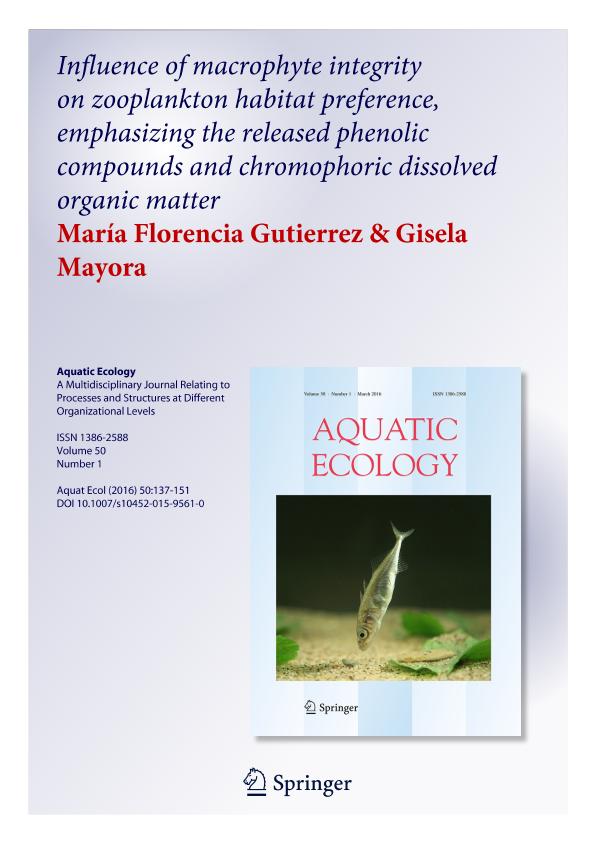Mostrar el registro sencillo del ítem
dc.contributor.author
Gutierrez, Marìa Florencia

dc.contributor.author
Mayora, Gisela Paola

dc.date.available
2018-09-16T14:42:49Z
dc.date.issued
2016-03
dc.identifier.citation
Gutierrez, Marìa Florencia; Mayora, Gisela Paola; Influence of macrophyte integrity on zooplankton habitat preference, emphasizing the released phenolic compounds and chromophoric dissolved organic matter; Springer; Aquatic Ecology; 50; 1; 3-2016; 137-151
dc.identifier.issn
1386-2588
dc.identifier.uri
http://hdl.handle.net/11336/59820
dc.description.abstract
Macrophyte health status can influence the composition of their exudates causing different effects on zooplankton behavior and distribution in nature. We hypothesize that: (1) the release of phenolic compounds and chromophoric dissolved organic matter (CDOM) depends on macrophyte species and its health status (broken macrophytes: BM, or healthy macrophytes: HM); (2) the repellency effect depends on zooplankton species, macrophyte species and its health status; and (3) higher concentrations of phenolic compounds and CDOM produce a stronger repellency effect. Phenolic compounds and CDOM were analyzed in exudates of BM and HM of Salvinia sp., Eichhornia crassipes, Pistia stratiotes, Azolla sp. and Ludwigia peploides. Through a flow-through experiment, the repellency produced by these exudates was assessed in two copepods (Notodiaptomus conifer and Argyrodiaptomus falcifer) and one cladoceran (Ceriodaphnia dubia). Our hypotheses were partially validated. The quantity of exudated phenolic compounds and CDOM depended on macrophyte species and, to a lesser extent, on the plant health status. The repellency effect was affected by macrophyte and zooplankton species but not by the health status of plants. Only C. dubia and A. falcifer increased their evasion behavior when phenolic compound and CDOM concentrations increased. In brief, the structuring effect of repellent substances depends on different factors. Under a certain threshold concentration, zooplankton behavior might depend on the information associated with the plant odor (e.g., predation risk, structural complexity) more than on the quantity of the released chemical compounds. Above this threshold, evasion would be the only possible option to avoid damaging effects.
dc.format
application/pdf
dc.language.iso
eng
dc.publisher
Springer

dc.rights
info:eu-repo/semantics/openAccess
dc.rights.uri
https://creativecommons.org/licenses/by-nc-sa/2.5/ar/
dc.subject
Aquatic Plants
dc.subject
Chemical Ecology
dc.subject
Evasion Behavior
dc.subject
Microcrustaceans
dc.subject.classification
Otras Ciencias Biológicas

dc.subject.classification
Ciencias Biológicas

dc.subject.classification
CIENCIAS NATURALES Y EXACTAS

dc.title
Influence of macrophyte integrity on zooplankton habitat preference, emphasizing the released phenolic compounds and chromophoric dissolved organic matter
dc.type
info:eu-repo/semantics/article
dc.type
info:ar-repo/semantics/artículo
dc.type
info:eu-repo/semantics/publishedVersion
dc.date.updated
2018-09-14T13:21:37Z
dc.journal.volume
50
dc.journal.number
1
dc.journal.pagination
137-151
dc.journal.pais
Alemania

dc.journal.ciudad
Berlin
dc.description.fil
Fil: Gutierrez, Marìa Florencia. Consejo Nacional de Investigaciones Científicas y Técnicas. Centro Científico Tecnológico Conicet - Santa Fe. Instituto Nacional de Limnología. Universidad Nacional del Litoral. Instituto Nacional de Limnología; Argentina
dc.description.fil
Fil: Mayora, Gisela Paola. Consejo Nacional de Investigaciones Científicas y Técnicas. Centro Científico Tecnológico Conicet - Santa Fe. Instituto Nacional de Limnología. Universidad Nacional del Litoral. Instituto Nacional de Limnología; Argentina
dc.journal.title
Aquatic Ecology

dc.relation.alternativeid
info:eu-repo/semantics/altIdentifier/doi/http://dx.doi.org/10.1007/s10452-015-9561-0
Archivos asociados
